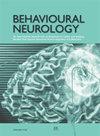Mitigated Oxidative Stress and Cognitive Impairments in Transient Global Ischemia using Niosomal Selegiline-NBP delivery
IF 2.7
4区 医学
Q2 CLINICAL NEUROLOGY
引用次数: 4
Abstract
Stroke is the most common reason for adult disabilities and the second ground for death worldwide. Our previous study revealed that selegiline serves as an alternative candidate in transient hypoxia-ischemia. However, aggressive and restless behavior was observed in stroke-induced rats receiving 4 mg/kg selegiline. In comparison, 1 mg/kg selegiline could induce negligible therapeutic effects on mitochondrial dysfunction and histopathological changes. Therefore, we designed oral noisome-based selegiline attached to 4-(4-nitrobenzyl) pyridine to improve transient global ischemia by attenuating cognitive impairments, oxidative stress, and histopathological injury. The investigation was performed in transient hypoxia-ischemia-induced rats by oral administration of nanoformulation containing selegiline (0.25-1 mg/kg) for 4 weeks (3 times a week). Novel object recognition (NOR) was considered to evaluate their cognitive dysfunction. Oxidative stress parameters and brain histopathological assessments were determined following the scarification of rats. Outstandingly, our data demonstrated slower selegiline release from niosomes relative to free drug, which was also in a controlled manner. Our data confirmed significant improvement in cognitive behavior in the NOR test, an increase in glutathione level and total antioxidant power, a decline in MDA and protein carbonyl level, as well as a decreased number of dead cells in histopathological assessment after being exposed to (0.5-1 mg/kg) selegiline-NBP nanoformulation. These data manifested that the selegiline-NBP nanoformulation (0.5-1 mg/kg) could significantly reduce oxidative damage, cognitive dysfunction, and histopathological damage compared to transient hypoxia-ischemia rats, which is 20 times lower than the therapeutic dose in humans. Therefore, the proposed nanoformulation would be capable as an alternative candidate without side effects in stroke.使用Niosomal Selegiline-NBP减轻短暂性全身缺血的氧化应激和认知障碍
中风是造成成人残疾的最常见原因,也是世界范围内死亡的第二大原因。我们之前的研究表明,司来吉林在短暂缺氧缺血中是一种替代候选药物。然而,在接受4 mg/kg司来吉林。相比之下,1 mg/kg司来吉林对线粒体功能障碍和组织病理学变化的治疗作用可忽略不计。因此,我们设计了与4-(4-硝基苄基)吡啶连接的口服黑色素硒吉林,通过减轻认知障碍、氧化应激和组织病理学损伤来改善短暂性全身缺血。通过口服含硒吉林(0.25-1 mg/kg)持续4周(每周3次)。新对象识别(NOR)被认为是评估他们的认知功能障碍。氧化应激参数和脑组织病理学评估是在大鼠的划痕后确定的。值得注意的是,我们的数据表明,与游离药物相比,硒吉林从niosomes中的释放较慢,这也是以可控的方式进行的。我们的数据证实,在NOR测试中,认知行为显著改善,谷胱甘肽水平和总抗氧化能力增加,MDA和蛋白质羰基水平下降,以及暴露于(0.5-1 mg/kg)硒吉林NBP纳米制剂。这些数据表明,硒吉林NBP纳米制剂(0.5-1 mg/kg)可以显著减少氧化损伤、认知功能障碍和组织病理学损伤,这比人类的治疗剂量低20倍。因此,所提出的纳米制剂将能够作为一种替代候选药物,在中风中没有副作用。
本文章由计算机程序翻译,如有差异,请以英文原文为准。
求助全文
约1分钟内获得全文
求助全文
来源期刊

Behavioural Neurology
医学-临床神经学
CiteScore
5.40
自引率
3.60%
发文量
52
审稿时长
>12 weeks
期刊介绍:
Behavioural Neurology is a peer-reviewed, Open Access journal which publishes original research articles, review articles and clinical studies based on various diseases and syndromes in behavioural neurology. The aim of the journal is to provide a platform for researchers and clinicians working in various fields of neurology including cognitive neuroscience, neuropsychology and neuropsychiatry.
Topics of interest include:
ADHD
Aphasia
Autism
Alzheimer’s Disease
Behavioural Disorders
Dementia
Epilepsy
Multiple Sclerosis
Parkinson’s Disease
Psychosis
Stroke
Traumatic brain injury.
 求助内容:
求助内容: 应助结果提醒方式:
应助结果提醒方式:


